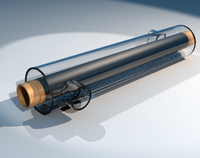
Photo from wikipedia
Abstract Numerical simulation of fully developed laminar fluid flow and heat transfer in non-circular sub-channel geometries representing a typical nuclear fuel bundle is carried out. The governing equations of fluid… Click to show full abstract
Abstract Numerical simulation of fully developed laminar fluid flow and heat transfer in non-circular sub-channel geometries representing a typical nuclear fuel bundle is carried out. The governing equations of fluid flow and heat transfer are reduced in the form of Poisson's equation and implemented in COMSOL multi physics code as classical PDEs. The fully developed laminar flow equations are solved on the non-circular sub-channel and fuel bundle geometries in a two dimensional domain cut in the longitudinal cross section. The domain is solved for the flow velocities in the out of plane direction by applying the pressure gradient as the boundary condition. The study is focused on the detailed analysis of the Poiseuille number (fRe) and average Nusselt number ( N u ¯ ) in square and triangular pitched sub-channel geometries of rod bundle. These investigations are carried out for two distinct boundary conditions as axially uniform wall heat flux with uniform wall temperature in the periphery (H1 Boundary condition) and uniform wall heat flux in both axial and circumferential directions (H2 boundary condition) for different p/d ratios varying from 1 to 2. It is found that the fRe increases significantly from 6.5 to 24 for p/d ratio of 1–1.15 for the sub-channel shaped geometry. In case of the sub-channel shaped tube of the same p/d ratio, the fRe increases sharply upto p/d ratio ∼1.15 and then starts decreasing slightly till the p/d ratio of 1.5. Analyses are also carried out for square pitched bundles of different sizes varying from 2 × 2 to 10 × 10 to find the variation of fRe with p/d and W/d in the laminar flow regime. The effect of bundle size on the variation of bundle friction factor (fRe) reveals that for an equal p/d and W/d ratios, the change in bundle friction factor (fRe) is within 5% and the effect of bundle sizes vanishes. Correlations are developed to predict the flow and heat transfer characteristics as a function of p/d ratio for non-circular sub-channels by least square regression analysis.
Journal Title: Progress in Nuclear Energy
Year Published: 2018
Link to full text (if available)
Share on Social Media: Sign Up to like & get
recommendations!